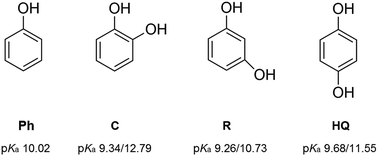Monitoring trace levels of hydroxy aromatic compounds in urine matrices by bar adsorptive microextraction (BAμE)
Abstract
In this study, the enhancement for trace analysis of hydroxy aromatic compounds (HACs), such as phenol, hydroquinone, catechol and resorcinol, in urine matrices is proposed using bar adsorptive microextraction combined with micro-liquid desorption followed by high-performance liquid chromatography with diode array detection (BAμE-μLD/HPLC-DAD). By comparing different polymers and activated carbons (ACs) as sorbent coatings for BAμE, the AC3 phase showed the best selectivity for the compounds under study. Assays performed through BAμE(AC3)-μLD on 25 mL of ultrapure water samples spiked at the 10.0 μg L−1 level showed recoveries ranging from 30.7 ± 0.6% to 99.8 ± 4.7%, under optimized experimental conditions. The validated method provided satisfactory limits of detection (0.1 to 0.4 μg L−1) and good linear dynamic ranges (0.4 to 80.0 μg L−1) with determination coefficients higher than 0.9925. The proposed analytical approach was applied to urine matrices using the standard addition methodologies, which has shown to be very effective in monitoring HACs in comparison to other dedicated analytical methods. Furthermore, it is easy to implement, has good reproducibility and sensitivity, and requires small amounts of sample and solvents in compliance with the green analytical chemistry principles.



 Please wait while we load your content...
Please wait while we load your content...